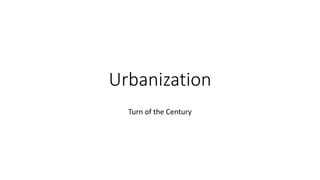
Urbanization ppt
- 1. Urbanization Turn of the Century
- 2. Overcrowding and Slums • As workers came to the cities, the middle-class moved to suburbs. • Previously middle-class homes were converted into tenements: low- cost rental housing that often barely met minimal living requirements. • Whole families would share single-room apartments. • Often there was no heat or lighting.
- 3. Lack of Sanitation and Pollution • No sewage systems. • Contaminated water caused outbreaks of cholera and typhoid. • Lack of ventilation in tenements contributed to the spread of disease. • Garbage-collection and street- cleaning services were inadequate. • Factories and railroads polluted the air, water, and ground with smoke, ash, and chemicals.
- 4. Lack of Sanitation and Pollution
- 5. Traffic Congestion • Until the turn of the century, horse- drawn cars crowded the streets of cities. • This made movement difficult. • Most streets were too small to accommodate the increased traffic. • Cable car, electric trollies, and electric subway all helped the flow of traffic.
- 6. Vast Differences in Wealth • The rich and the poor lived very close together. • The rich were famous for throwing lavish parties, just to display their wealth. • There was tension between the classes because they were so close together.
- 7. Political Corruption • Many American cities were run by political machines: organizations usually controlled by a leader (boss) that gets citizens to vote for candidates on election day. • People worked for the “machine” in exchange for political favors. • Political bosses provided jobs and services to immigrants and other poor residents in return for their votes.
- 8. Political Corruption • Political machines used their control of city governments to make money by overcharging on city contracts (construction, etc.) • Tammany Hall: one of the most famous political machines, located in NYC. • Named and elected mayors and government officials. • “Ward Bosses” were assigned to each section of the city, to gather votes. • Boss Tweed was one of the most corrupted politicians during this time period.
- 9. Political Corruption • Political machines and their bosses did provide important social services to those in need at a time when government did very little. • They would lend money, provide jobs, give emergency assistance (food, coal, rent). • Encouraged and helped immigrants to assimilate and become citizens.
- 10. Rise of the Skyscraper • Skyscrapers began to develop as a result of urban overcrowding. • Used for residential, business, and industrial purposes.